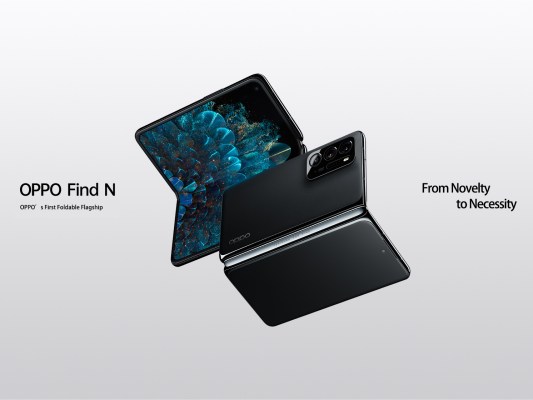The crease, it seems, is unavoidable. It’s right there, smack in the middle of the those big, expensive folding displays. And it’s invariably (and perhaps understandably) the first comment on nearly every story I post about a foldable phone. The alternative isn’t ideal, either — a gap between two distinct displays à la Microsoft’s Surface Duo.
The “N” in Oppo’s new Find N foldable doesn’t stand for “no crease,” exactly, but all reports thus far point to a reduction of that being among the biggest aesthetic complaints revolving around the first few generations of foldables. It is, according to Oppo, “up to 80% less noticeable” than on standard foldables. Crease detection is, of course, in the eye of the beholder, but more than anything, it depends on how the light hits the screen.
But either way, the crease has been a kind of nagging nuisance — far more than the notch — in the fact that it cuts right down the center of the screen. What’s notable here is how much work Oppo has been putting in behind the scenes. The company decidedly did not rush this thing to market. It reportedly comes on the tail of six generations of internally developed prototypes as part of a project the hardware maker has been operating since 2018.
The whole of the foldable landscape has decidedly been a mixed bag, thus far — with some of those failures self-inflected. The broad consensus is that Samsung was just too quick to market with its first foldable, though subsequent generations have made the product much more viable for consumer usage. There’s nothing mainstream about them yet (sorry Samsung), but they’ve undoubtedly come a long way, and the Galaxy Z Flip 3 is the first time I’ve seriously thought “I could use this phone” during the testing process.
Huawei’s original Mate X was promising the few times I had occasion to use it, but that, too, was sidelined when the company ultimately went back to the drawing board. And in the meantime, other, bigger issues than that have been plaguing the hardware maker. Meanwhile, Motorola’s first attempt at a foldable Razr was a flop, though it has managed to correct some of those mistakes with a second generation.
From the looks of it, Oppo has avoided some of those pitfalls by waiting. Truth of the matter is, in this industry, being the first to something isn’t always an advantage. At a certain point in the process, you’re effectively doing widespread beta testing among early adopters. And while I sadly wasn’t at Oppo’s big show this week (though Rita’s been doing a splendid job covering it for us), hands-ons have been complimentary with regards to the numerous things the company did right here.
At the very least, it’s easy to see Oppo got a lot right with the 18:9 aspect ratio in that — unlike other foldables — it looks like a phone when closed. It’s admittedly pretty thick when closed, but the hinge does a good job keeping the displays flush. At 7.1-inches, the screen falls short of the Fold 3’s 7.6-inches, though I suspect the former is large enough for most folks who feel compelled toward these devices.
It’s worth noting, too, that Samsung Display made the folding screen (though Oppo says it did a lot of proprietary work on top) — which means that, even if Oppo does well, Samsung still gets a cut. A rising tide lifts all boats, I suppose, assuming all of those boats happen to be largely comprised of Samsung components.
The rub here — and it’s a big one — is that this is a China-only device. The world’s largest smartphone market, it seems, is enough for Oppo. Of course, now that OnePlus has effectively ahem folded into Oppo, perhaps there’s some opportunity for synergy there. The brand has notably been toying around with its own foldable concepts of late.
